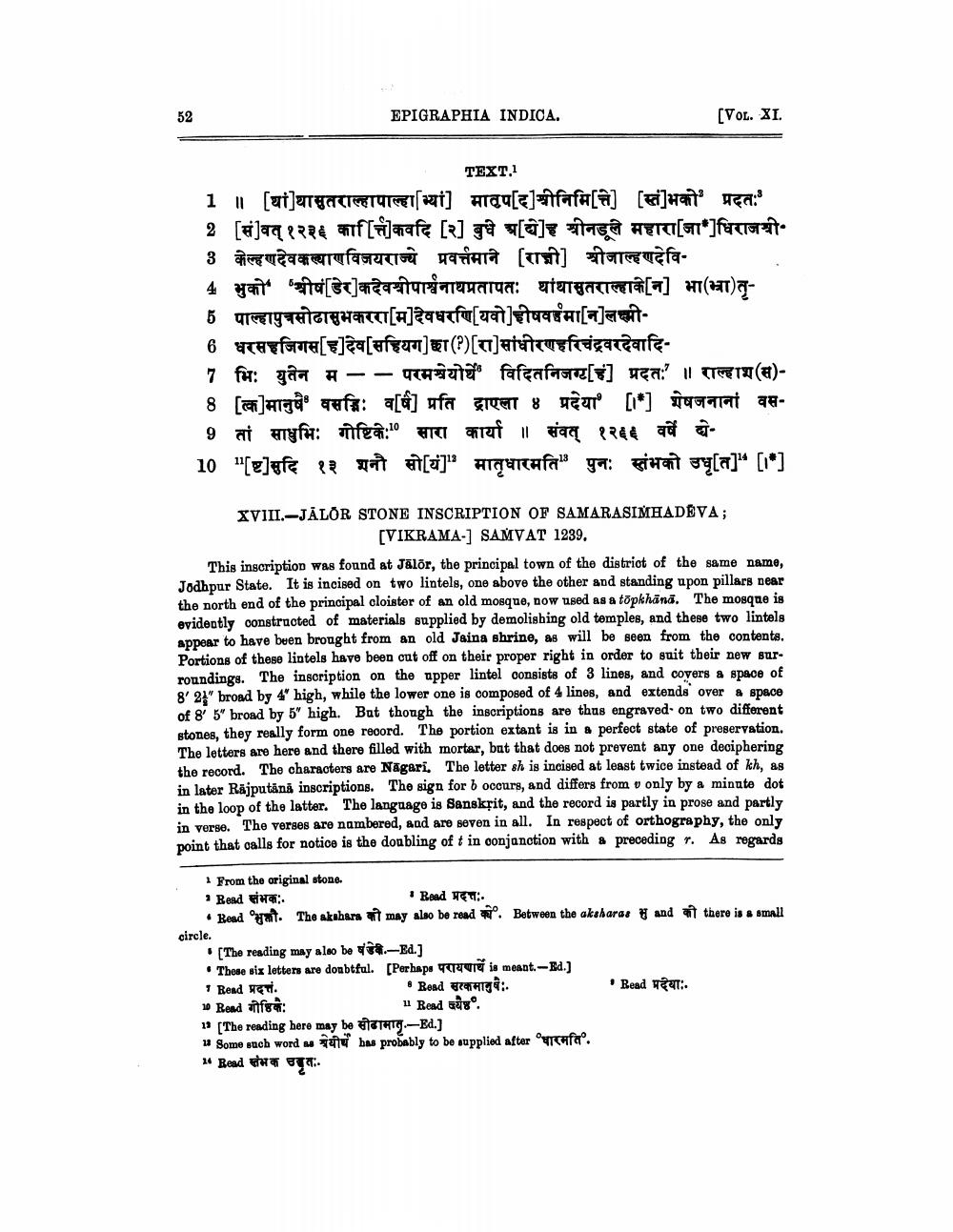________________
EPIGRAPHIA INDICA.
[Vor. XI.
TEXT.I 1 ॥ [थां]थासुतराल्हापाल्हा[भ्यां] मातृप[द] श्रीनिमित्ते] [स्तं]भको प्रदतः 2 [संवत् १२३६ काति] कवदि [२] बुधे अधेि]ह श्रीनडूले महारा[जा ]धिराजश्री. 3 केल्हणदेवकल्याणविजयराज्ये प्रवर्त्तमाने [राज्ञी] श्रीजाल्हणदेवि4 भुको' 'श्रीष डेर]कदेवश्रीपार्श्वनाथप्रतापतः थांथासुतराल्हाके[न] भा(भ्रातृ6 पाल्हापुत्रसोढासुभकररा[म]देवधरणि[यवोहीषवईमान लक्ष्मी6 धरसहजिगस[ह]देव[सहियग] छा (?)[स]सांधारणहरिचंद्रवरदेवादि7 भिः युतेन म-- परमश्रेयोर्थे विदितनिजग्र[६] प्रदतः ॥ राल्हाश(स)8 [क]मानुषे वसद्भिः वर्ष प्रति द्राएला ४ प्रदेया' [*] श्रेषजनानां वस9 तां साधुभिः गोष्टिके:10 सारा कार्या ॥ संवत् १२६६ वर्षे ये10 "[ष्ट]सुदि १३ शनी सो[य]" मातृधारमति" पुन: स्तंभको उधृति]" [1"]
XVIII.-JĀLOR STONE INSCRIPTION OF SAMARASIMHADEVA;
[VIKRAMA-] SAMVAT 1239. This inscription was found at Jalor, the principal town of the district of the same name, Jodhpur State. It is incised on two lintels, one above the other and standing upon pillars near the north end of the principal cloister of an old mosque, now used as a topkhāna. The mosque is evidently constructed of materials supplied by demolishing old temples, and these two lintels appear to have been brought from an old Jaina shrine, as will be seen from the contents. Portions of these lintels have been cut off on their proper right in order to suit their new surroundings. The inscription on the upper lintel consists of 3 lines, and covers a space of 8' 21" broad by 4' high, while the lower one is composed of 4 lines, and extends over & space of 8' 5" broad by 5" high. But though the inscriptions are thus engraved on two different stones, they really form one record. The portion extant is in a perfect state of preservation. The letters are here and there filled with mortar, but that does not prevent any one deciphering the record. The characters are Nagari. The letter sh is incised at least twice instead of kh, as in later Rajputans inscriptions. The sign for b occurs, and differs from v only by a minute dot in the loop of the latter. The language is Sanskrit, and the record is partly in prose and partly in verse. The verses are nambered, and are seven in all. In respect of orthography, the only point that calls for notice is the doubling of t in conjanction with a preceding . As regards
there is a small
1 From the original stone. Rend संभक:
Bad प्रदत:• Read at. The skaars ū may also be read . Between the aksharas and circle.
'[The reading may also be पंडेक.-Ed.] • Those six letten are donbtful. [Parhaps परायणार्थे 1m moant-Rd.] 1 Read प्रदत्तं. • Read सरकमानुषैः
• Read प्रदेया:• Read गोष्ठिकः
" Read क्य . " [The reading here may be सीढामात.-Ed.] u Some saob word n has probably to be supplied after Ourchfa. " Read स्तंभक उदृतः




